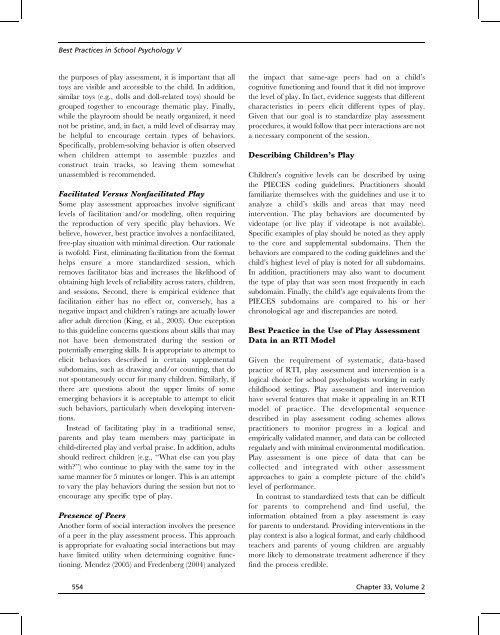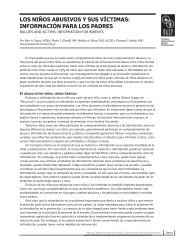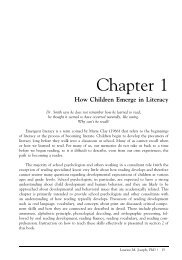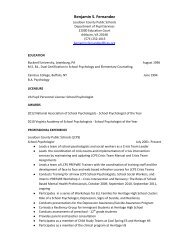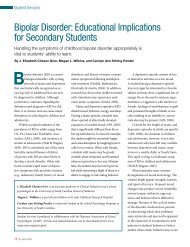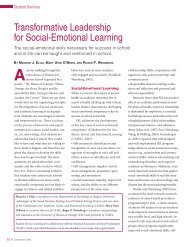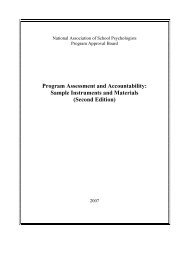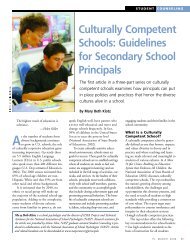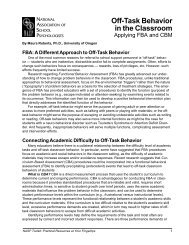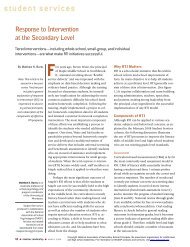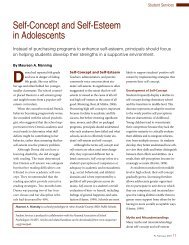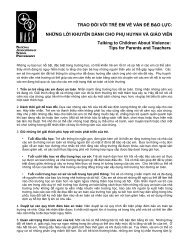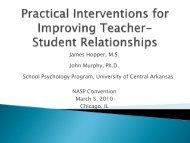Best Practices in Play Assessment and Intervention
Best Practices in Play Assessment and Intervention
Best Practices in Play Assessment and Intervention
Create successful ePaper yourself
Turn your PDF publications into a flip-book with our unique Google optimized e-Paper software.
<strong>Best</strong> <strong>Practices</strong> <strong>in</strong> School Psychology V<br />
the purposes of play assessment, it is important that all<br />
toys are visible <strong>and</strong> accessible to the child. In addition,<br />
similar toys (e.g., dolls <strong>and</strong> doll-related toys) should be<br />
grouped together to encourage thematic play. F<strong>in</strong>ally,<br />
while the playroom should be neatly organized, it need<br />
not be prist<strong>in</strong>e, <strong>and</strong>, <strong>in</strong> fact, a mild level of disarray may<br />
be helpful to encourage certa<strong>in</strong> types of behaviors.<br />
Specifically, problem-solv<strong>in</strong>g behavior is often observed<br />
when children attempt to assemble puzzles <strong>and</strong><br />
construct tra<strong>in</strong> tracks, so leav<strong>in</strong>g them somewhat<br />
unassembled is recommended.<br />
Facilitated Versus Nonfacilitated <strong>Play</strong><br />
Some play assessment approaches <strong>in</strong>volve significant<br />
levels of facilitation <strong>and</strong>/or model<strong>in</strong>g, often requir<strong>in</strong>g<br />
the reproduction of very specific play behaviors. We<br />
believe, however, best practice <strong>in</strong>volves a nonfacilitated,<br />
free-play situation with m<strong>in</strong>imal direction. Our rationale<br />
is twofold. First, elim<strong>in</strong>at<strong>in</strong>g facilitation from the format<br />
helps ensure a more st<strong>and</strong>ardized session, which<br />
removes facilitator bias <strong>and</strong> <strong>in</strong>creases the likelihood of<br />
obta<strong>in</strong><strong>in</strong>g high levels of reliability across raters, children,<br />
<strong>and</strong> sessions. Second, there is empirical evidence that<br />
facilitation either has no effect or, conversely, has a<br />
negative impact <strong>and</strong> children’s rat<strong>in</strong>gs are actually lower<br />
after adult direction (K<strong>in</strong>g, et al., 2003). One exception<br />
to this guidel<strong>in</strong>e concerns questions about skills that may<br />
not have been demonstrated dur<strong>in</strong>g the session or<br />
potentially emerg<strong>in</strong>g skills. It is appropriate to attempt to<br />
elicit behaviors described <strong>in</strong> certa<strong>in</strong> supplemental<br />
subdoma<strong>in</strong>s, such as draw<strong>in</strong>g <strong>and</strong>/or count<strong>in</strong>g, that do<br />
not spontaneously occur for many children. Similarly, if<br />
there are questions about the upper limits of some<br />
emerg<strong>in</strong>g behaviors it is acceptable to attempt to elicit<br />
such behaviors, particularly when develop<strong>in</strong>g <strong>in</strong>terventions.<br />
Instead of facilitat<strong>in</strong>g play <strong>in</strong> a traditional sense,<br />
parents <strong>and</strong> play team members may participate <strong>in</strong><br />
child-directed play <strong>and</strong> verbal praise. In addition, adults<br />
should redirect children (e.g., ‘‘What else can you play<br />
with?’’) who cont<strong>in</strong>ue to play with the same toy <strong>in</strong> the<br />
same manner for 5 m<strong>in</strong>utes or longer. This is an attempt<br />
to vary the play behaviors dur<strong>in</strong>g the session but not to<br />
encourage any specific type of play.<br />
Presence of Peers<br />
Another form of social <strong>in</strong>teraction <strong>in</strong>volves the presence<br />
of a peer <strong>in</strong> the play assessment process. This approach<br />
is appropriate for evaluat<strong>in</strong>g social <strong>in</strong>teractions but may<br />
have limited utility when determ<strong>in</strong><strong>in</strong>g cognitive function<strong>in</strong>g.<br />
Mendez (2005) <strong>and</strong> Fredenberg (2004) analyzed<br />
the impact that same-age peers had on a child’s<br />
cognitive function<strong>in</strong>g <strong>and</strong> found that it did not improve<br />
the level of play. In fact, evidence suggests that different<br />
characteristics <strong>in</strong> peers elicit different types of play.<br />
Given that our goal is to st<strong>and</strong>ardize play assessment<br />
procedures, it would follow that peer <strong>in</strong>teractions are not<br />
a necessary component of the session.<br />
Describ<strong>in</strong>g Children’s <strong>Play</strong><br />
Children’s cognitive levels can be described by us<strong>in</strong>g<br />
the PIECES cod<strong>in</strong>g guidel<strong>in</strong>es. Practitioners should<br />
familiarize themselves with the guidel<strong>in</strong>es <strong>and</strong> use it to<br />
analyze a child’s skills <strong>and</strong> areas that may need<br />
<strong>in</strong>tervention. The play behaviors are documented by<br />
videotape (or live play if videotape is not available).<br />
Specific examples of play should be noted as they apply<br />
to the core <strong>and</strong> supplemental subdoma<strong>in</strong>s. Then the<br />
behaviors are compared to the cod<strong>in</strong>g guidel<strong>in</strong>es <strong>and</strong> the<br />
child’s highest level of play is noted for all subdoma<strong>in</strong>s.<br />
In addition, practitioners may also want to document<br />
the type of play that was seen most frequently <strong>in</strong> each<br />
subdoma<strong>in</strong>. F<strong>in</strong>ally, the child’s age equivalents from the<br />
PIECES subdoma<strong>in</strong>s are compared to his or her<br />
chronological age <strong>and</strong> discrepancies are noted.<br />
<strong>Best</strong> Practice <strong>in</strong> the Use of <strong>Play</strong> <strong>Assessment</strong><br />
Data <strong>in</strong> an RTI Model<br />
Given the requirement of systematic, data-based<br />
practice of RTI, play assessment <strong>and</strong> <strong>in</strong>tervention is a<br />
logical choice for school psychologists work<strong>in</strong>g <strong>in</strong> early<br />
childhood sett<strong>in</strong>gs. <strong>Play</strong> assessment <strong>and</strong> <strong>in</strong>tervention<br />
have several features that make it appeal<strong>in</strong>g <strong>in</strong> an RTI<br />
model of practice. The developmental sequence<br />
described <strong>in</strong> play assessment cod<strong>in</strong>g schemes allows<br />
practitioners to monitor progress <strong>in</strong> a logical <strong>and</strong><br />
empirically validated manner, <strong>and</strong> data can be collected<br />
regularly <strong>and</strong> with m<strong>in</strong>imal environmental modification.<br />
<strong>Play</strong> assessment is one piece of data that can be<br />
collected <strong>and</strong> <strong>in</strong>tegrated with other assessment<br />
approaches to ga<strong>in</strong> a complete picture of the child’s<br />
level of performance.<br />
In contrast to st<strong>and</strong>ardized tests that can be difficult<br />
for parents to comprehend <strong>and</strong> f<strong>in</strong>d useful, the<br />
<strong>in</strong>formation obta<strong>in</strong>ed from a play assessment is easy<br />
for parents to underst<strong>and</strong>. Provid<strong>in</strong>g <strong>in</strong>terventions <strong>in</strong> the<br />
play context is also a logical format, <strong>and</strong> early childhood<br />
teachers <strong>and</strong> parents of young children are arguably<br />
more likely to demonstrate treatment adherence if they<br />
f<strong>in</strong>d the process credible.<br />
554 Chapter 33, Volume 2


